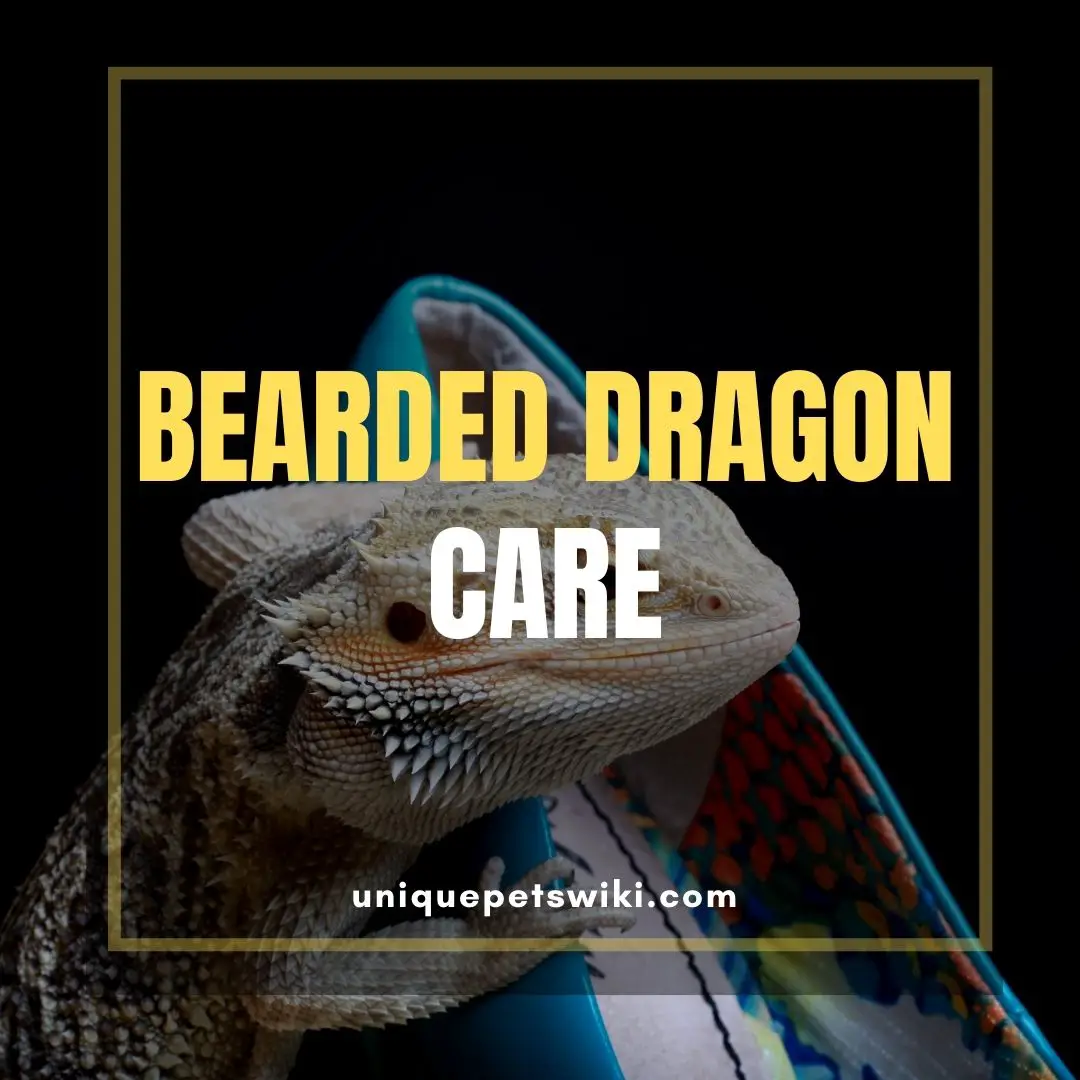Bearded dragons are increasingly becoming a popular pet, and bearded dragon care isn’t much difficult. If you need advice on how to look after your beloved lizard, here is the place for you.
When caring for bearded dragons, you need to know a lot of things, including their diet, housing, behaviors, and breeding, among others. It is quite hard to give your dragon a comfortable life if you don’t understand their needs.
In this article, we will learn everything you need to know about giving utmost care to your bearded dragon.
Contents
- What are Bearded Dragons?
- Why Do Bearded Dragons Make Good Pets?
- The Cost of Caring for and Raising a Bearded Dragon
- Where Can I Buy a Bearded Dragon?
- What Kind of Home Does My Bearded Dragon Need?
- How Do I Choose the Right Bearded Dragon for Me?
- What Should I Feed My Bearded Dragon?
- What Should NOT I Feed My Bearded Dragon?
- How Do I Take Care of My Bearded Dragon?
- 15 Fun Facts About Bearded Dragons
- Head-bobbing
- Black Beard
- Arm-waving
- Bearded Dragons Come in Different Morphs
- Bearded Dragons can Run on Two Legs
- The Beardies can Swim Perfectly
- Bearded Dragons can Run up to 9mph
- They are Exceedingly Affectionate
- Bearded Dragons can Sleep while Standing
- They Sit with their Mouth Open
- Eye Bulging
- Bearded Dragons Express Dominance and are Good in Bullying
- Bearded Dragons Stress Marks
- Shedding Process
- Bearded Dragons Like to Climb Trees
- Conclusion
What are Bearded Dragons?
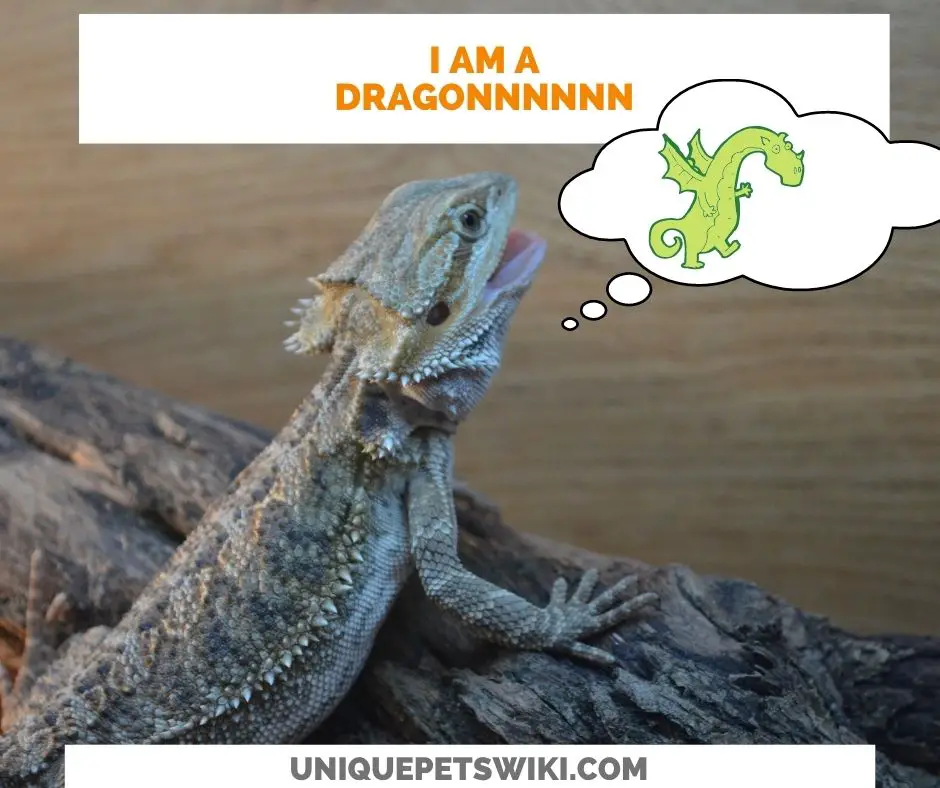
Bearded dragons are Australian lizards that belong to genus pogona, and they have a distinct pouch (beard) under the jaw and spiny scales on the back and side.
Young bearded dragons are semi-arboreal, but the adults are mainly terrestrial and primarily climb on trees for basking reasons. They are called ‘bearded’ due to the presence of a pouch that puffs up when the lizard feels threatened or due to territoriality.
The beard usually turns black when the dragon is puffing up, and it happens in both males and females but more common in males.
Appearance and Origin
There are different morphs of bearded dragons, and they all differ from each other in terms of body patterns and color. The color ranges from tan, yellow, red, and possess black and orange markings.
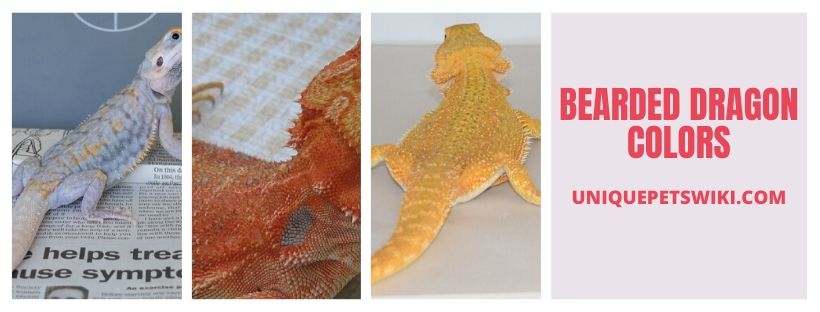
Bearded dragons are native to Inland Australia and inhabit places like arid open woodlands, rocky areas, semi-desert regions and dry areas. They are well-adapted to the hot environment in the desert and extreme cold at night.
During the day when the temperatures are too hot, the beardies usually stay in underground burrows. That’s how they live in their natural habitat. In captivity, you need to provide a habitat that mimics the natural environment of bearded dragons for the safety of your pet.
Bearded Dragon Care: Gender Differences and Mating
There is no different way on how you should care for different genders of bearded dragons, but it is always important to know how to distinguish the males from females.
To get precise results, wait until your lizard is about two months old and then you can determine its sex.
Different methods will help you identify whether a bearded dragon is male or female, including behaviors, femoral pore size, and hemipenal bulges.
Hemipenal bulges are the bumps under the tail of the beardies and near to the anus. Males have two bumps located at both sides of the tail but underneath. On the other hand, females possess one hemipenal bulge, but it is situated in the centre of the tail on the underside.
Femoral pores are spots that run from one hind leg to another on the bottom, and they are responsible for secreting pheromones that help in communication during mating.
Males show larger spots, and they are well pronounced, but the pores are small and somehow faded in females. When it comes to behaviors, head bobbing and black-bearded is more common in males than females. Also, females tend to wave their arms more often.
Bearded dragon Mating
Wild bearded dragons typically mate in spring after coming from brumation while in captivity they can breed any month of the year.
Before putting your lizard pets together to mate, you need to consult an expert or your reptile vet and get the right steps to follow for the safety of your lizards and the offspring.
There is more you need to know when it comes to bearded dragon breeding.
Note that, not all morphs of the beardies should be bred and that’s why you need to have good knowledge in breeding bearded dragons to prevent making mistakes.
Why Do Bearded Dragons Make Good Pets?
Bearded dragons are easy to care for as they don’t grow too big and eat less food compared to household pets like dogs, cats, etc.
But the most interesting thing about beardies is their warm personality, and this makes many people love them.
The beardies are gentle and docile and can live well with children. So, owning a bearded dragon provides a good chance for your kids to learn about these fascinating desert creatures. Many children enjoy having a good time with their lizard pets.
Also, bearded dragons are lovely pets for beginners because they are affordable; once you purchase and set up their terrarium, things become cheaper.
If you are looking for pets with long life-expectancy, bearded dragons are a great choice.
A dragon eating healthy foods lives a stress-free life and is under extreme care can live up to 20 years. But, the standard lifespan of bearded dragons is 12-15 years in captivity.
The Cost of Caring for and Raising a Bearded Dragon
If you are looking forward to having a lizard pet, the beardies are a better choice as they have low maintenance. Additionally, bearded dragons are great pets to start with if it’s your first time to own a pet.
It only takes a few minutes to feed a beardie and clean its enclosure. Another interesting thing as far as caring goes, bearded dragons don’t have a complicated diet.
How Much Does a Bearded Dragon Cost?
If you are interested in having a bearded dragon, you need to consider its costs first. How much to buy a beardie depends on where you buy it from, the type of morph, age, and other factors.
However, a bearded dragon can cost anywhere from $50 to $100 on average. There are various places to purchase a dragon, including from breeders, pet stores, craigslist, reptile shows, among others.
Cage Setup
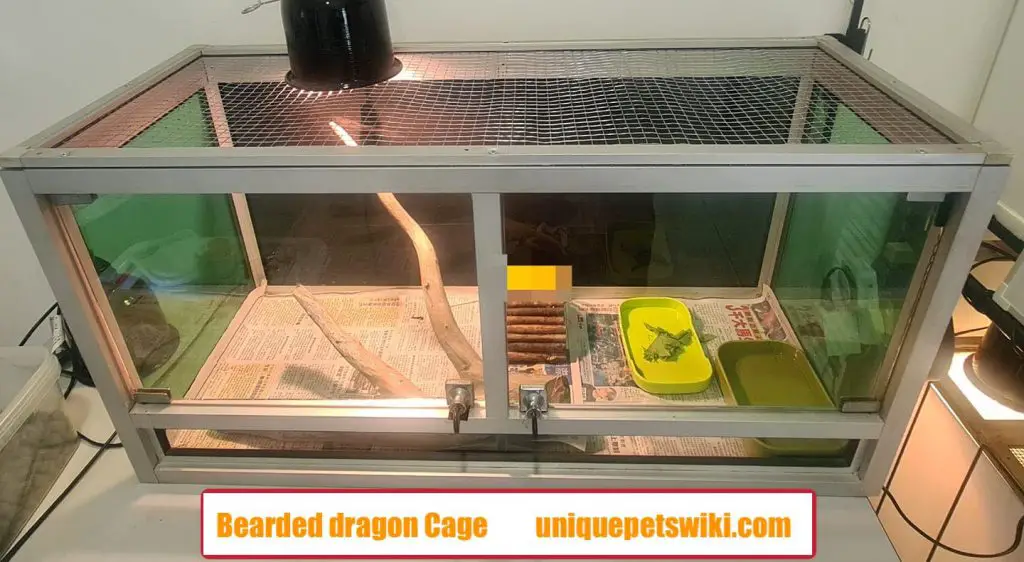
Setting up a bearded dragon vivarium is a little bit expensive as it needs to have a UV light, hides, heat lamp and other accessories. The cost of buying a vivarium varies depending on its size and design.
Ideally, a bearded baby dragon will do best in a vivarium of 40 gallons in size while adult beardies should have a minimum of 75 gallons tank. Providing a sufficient space is necessary to allow the lizard to live a comfortable life and express its natural behaviors fully.
So, you will need a minimum of $50-$200 to purchase a terrarium depending on the age of your dragon. Some cages can also go as high as $500-$700 depending on the design.
Cost for Food
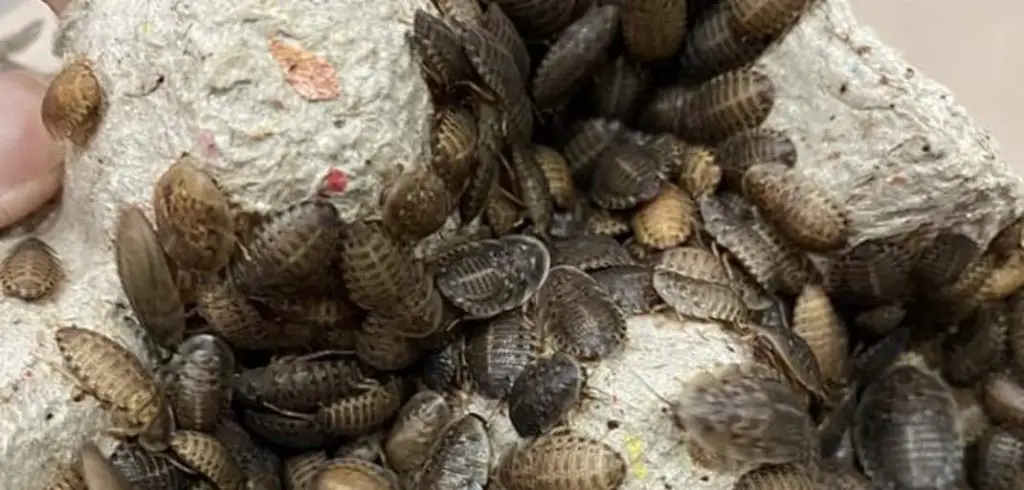
It would help if you considered the cost of feeding a bearded dragon, but it isn’t much expensive. The beardies eat a variety of foods, such as insects, fruits, veggies, and greens.
In one month, you will need about $30-$80 for buying feeder insects depending on where you purchase them. Greens are cheaper, and you can spend around $5, but it will depend on the age of your lizard. The veggies can cost you approximately $10.
Of course, the beardies need supplements, and you can end up spending nearly $30 on supplements every 6-12 months. In total, you need a maximum amount of $130 for feeding a bearded dragon per month.
Cohabitation
The beardies neither walk-in groups, cohabit nor have family ties in their natural habitat. They are solitary and independent creatures, and they appreciate being that way.
So, it is upon you to provide your dragons with a separate vivarium, especially the males. You should never keep two male bearded dragons in the same terrarium as it is a big gamble.
Housing a male and female dragon in one enclosure can work well but beware of the reproduction possibility. Frequent mating can cause stress to the female or health issues in case the female is below two years.
Two females can get along well with each other, but they should be of the same size and age. Females are also relatively famous for fighting and getting aggressive.
Keeping a beardie alone in a cage is the best decision, so you can be sure that it will be happy and healthy.
Medical Cost
While calculating other costs, never forget the cost of veterinary care as it is significant for the well-being of your pet. Typically, to visit a reptile vet for consultation, it can cost you between $25-$100 without including the test or treatment costs.
And this means that if your lizard is sick, you can get substantial vet bills. Fortunately, there’s bearded dragon insurance which can cover about 90% of your vet bills. The price of reptile health insurance varies from one region to another, but it can go as low as $5 a month.
Where Can I Buy a Bearded Dragon?
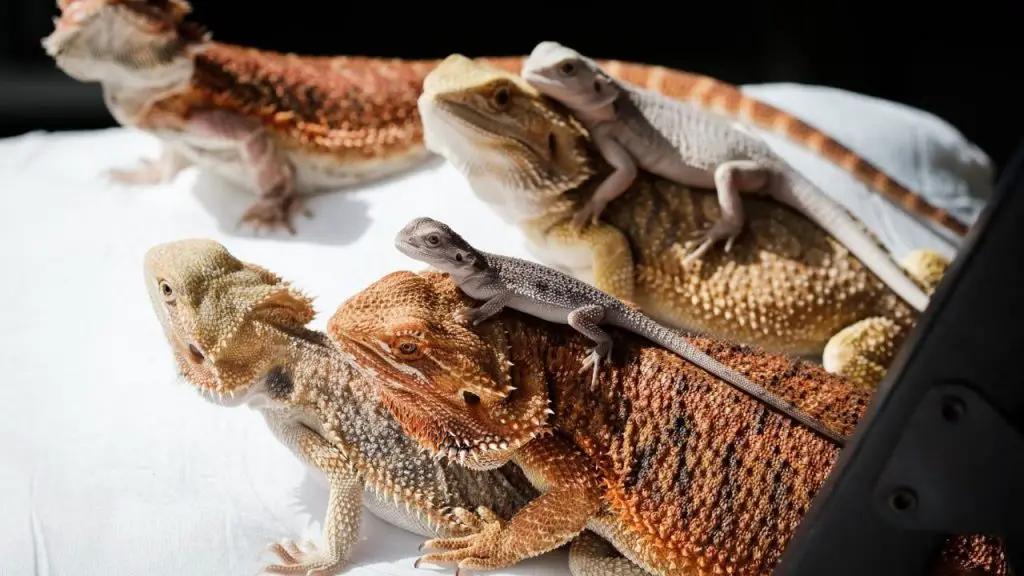
You can buy a bearded dragon from breeders, pet stores, reptile rescues, or classified Ads/Facebook Groups.
Pet Stores
Most people would prefer to go to local pet stores because it’s easy to access them. However, this is not always the best place to get a bearded dragon. While some pet stores will give the utmost care to their beardies, others will not.
The beardies may also be bred poorly, and this means you can end up buying a lizard with health issues. Generally, the price of bearded dragons from pet stores ranges between $40-$60. Some also sell fancy dragons at a much higher cost of approximately $100.
Breeders
The best place to obtain a bearded dragon is from the breeders with good experience in the breeding process. Breeders follow the right procedure in the breeding and will always consider the health of the beardies before breeding.
You can ask for a good breeder from a reptile veterinarian. Reptile vets not only know breeders around but also how qualified they are, and the care they give their dragons. Breeders tend to be cheaper by an average of 15% below the price in local pet stores.
Classified Ads/Facebook Groups
You can also buy a bearded dragon from the online platforms. For instance, you can visit kingsnake.com’ bearded dragon classifieds where there are posting of the beardies on sale.
There are other classified ads where people from different areas sell their bearded dragons and at an affordable price. Likewise, many Facebook groups bring various dragon owners or experts together for sharing knowledge or advice concerning the beardies.
Some of these groups allow the members to sell bearded dragons and you can buy from them.
Reptile Rescues
The primary task rescue centres are to rescue bearded dragons and other reptiles that don’t have homes. The beardies can lose their home out of neglection, abuse, or the owners don’t want to continue keeping them for different reasons.
The rescues provide a favorable home for such bearded dragons and ensure they live a happy life. The rescues charge a small fee for the adoption of the beardie, but some tend to be free.
These are people who love bearded dragons, and they will want to make sure that you care for the beardie appropriately. Rescuing is a good thing as it is one way to help a lizard that is in need.
What Kind of Home Does My Bearded Dragon Need?
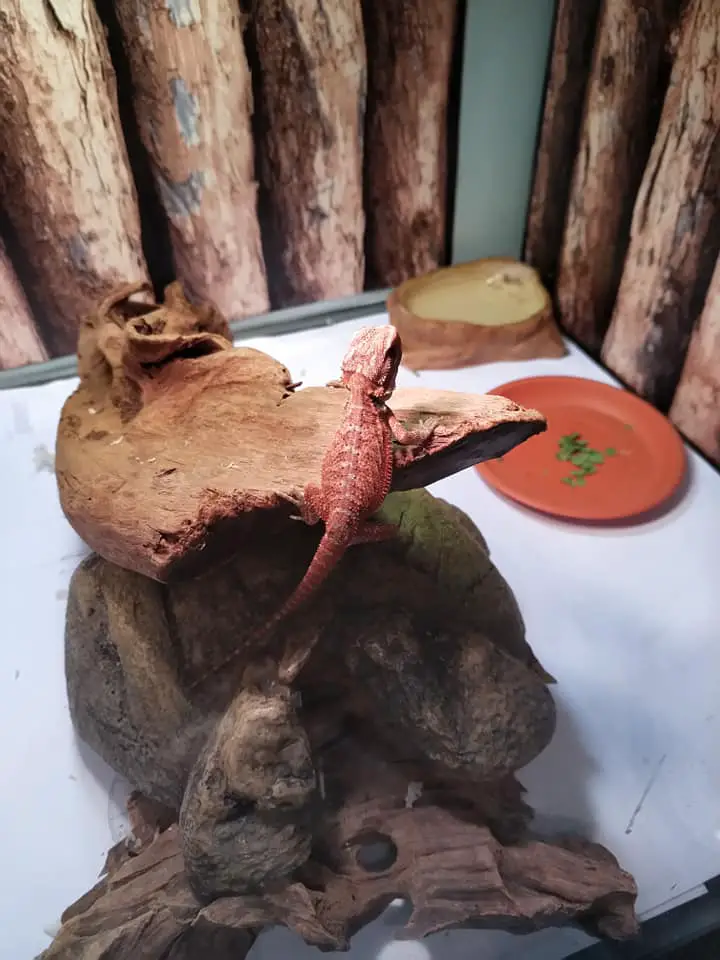
The size of the vivarium to buy depends on the age and how big your bearded dragon is. Keep the temperature and humidity at an ideal level. Bearded dragons need a temperature between 90-110℉ depending on the age.
Use the right substrate for your beardies enclosure. Carpets are renowned substrates as they are easy to clean, free from dust, and the beardies can’t eat them. Sand, on the other hand, can cause impaction when the dragon swallows them.
Make sure to use a digital thermometer and hygrometer to monitor the temperature and humidity, respectively. Also, keep the lights on for 12 hours daily and don’t allow the temperatures to drop below 70℉ at night.
Tank
As far as setting a bearded dragon tank goes, keep in mind that your lizard needs vary as it ages and increases in length. You can decide to make an enclosure yourself or purchase a built one.
The beardies need a tank made from plastics that are resistant to heat and safe for animals, such as PVC. The terrarium can also consist of glass or melamine-coated wood. Proper spacing is necessary for any bearded dragon to enable it to live comfortably.
Baby bearded dragons thrive well in a 20-40 gallons tank. Ideally, a 40 gallons tank best to provide sufficient space. Juveniles that are 15 inches or below need a 40-55 gallons tank while a 55-75 gallons tank is better for adults between 16-20 inches.
Adults that are above 20 inches in length need a larger tank which should range between 75-120 gallons. Remember that the larger sizes are a better option, and they provide sufficient space.
Basking Accessories Like Branches, Rocks, and Hidey-Holes
Bearded dragons are semi-arboreal, and this calls for the need to provide climbing areas in the enclosure. Provide smooth rocks where the dragon will rest while basking and also to wear down its nails.
A hiding place is also necessary to provide a resting area or allow the beardie to hide during different situations. For instance, if the lizard mistakes something to be a predator, it usually hides in the hidey-hole to calm down and feel safe.
Dishes and Bowls
Bearded dragons need water like any other animal to survive, remain hydrated and healthy. But that’s not enough; they need to eat and drink from clean and decent dishes and bowls.
However, not all bearded dragons will drink water from a bowl, and their primary source of hydration is vegetables, fruits, live food, misting or through bathing. Always put a bowl of water on the cooler side in the tank as a beardie’s hydration point.
There are many options for terrarium bowls where you can choose one for your lizard. Clean the dishes always, and put clean water every day. Zoo Med wipes out 1 Terrarium cleaner is useful in disinfecting, deodorizing, and cleaning the beardies enclosure and bowls.
How Do I Choose the Right Bearded Dragon for Me?
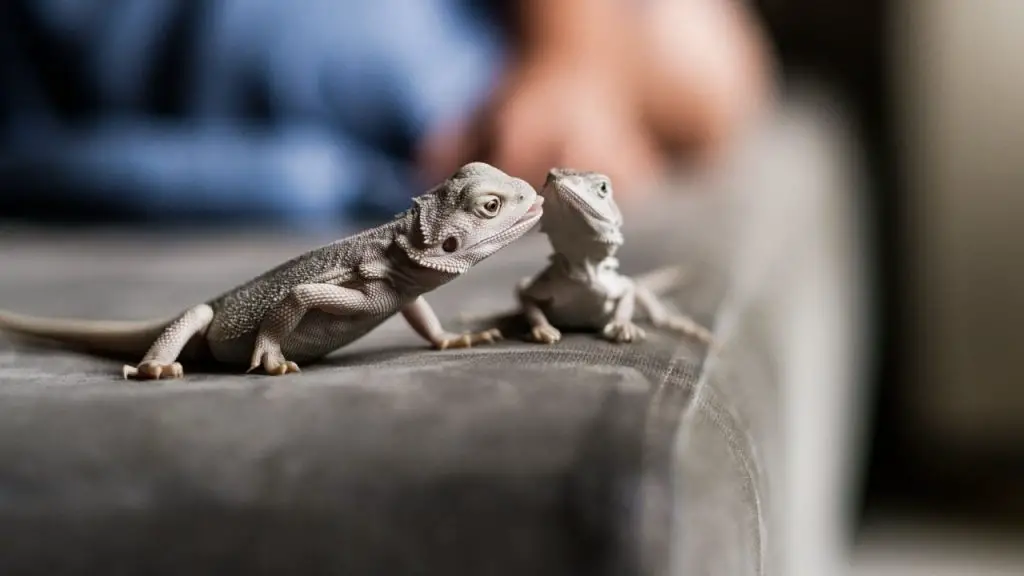
When planning to buy a bearded dragon, there are various factors you need to consider to get the right lizard for you.
The beardie sellers will always talk about the positive side of their animals, but you will not hear them telling you about the negative things. So, it is upon you as a buyer to know what to check in bearded dragons before buying.
Check the following factors that you should look for to make sure you end up with a good dragon.
- Look for a healthy dragon that is alert and active. An alert lizard will quickly notice your approach.
- Find an active and interactive lizard. Choose the one that is responding to you and appear to love being handled.
- Make sure that the size of the dragon matches its age. A bearded dragon size chart can help you determine the approximate size of a particular dragon’s age. Avoid hatchlings that are too short as they might have problems adapting to a new environment.
Bearded Dragon Health Checklist
You want a pet that will give you a long time of companionship and a healthy one, right?
- Consider scrutinizing the pet to make sure there are no physical injuries like burns, scars, etc.
- The dragon should be free from runny eyes, and there’s no puss on its face.
- Ensure that the beardie has all its body parts. Once bearded dragons lose their toes, tail, or limbs, they don’t regrow.
- Ensure that it has a pink mouth and tongue. These are good signs for a healthy bearded dragon.
- Check the skin and make sure the lizard is well hydrated. You can pull up the skin and release it to see if it returns to a normal position immediately.
- Look for a dragon with big fat stores at the tail’s bottom. The tail should be curled up towards the head, and this indicates that the dragon is healthy.
Play with your Bearded Dragons (toys, games)
Making your bearded dragon happy is the first thing every bearded dragon owner wants for their beloved pet. Choosing the best toys or games that your pet will enjoy is quite tricky.
But don’t worry, I have a list of best toys and games to involve your dragon.
- Mirror
- Cat toys
- A taped ball that has insects inside
- Swimming
- Watching TV
- Have a cuddle
- Caves and hides
- Tunnel
- Laser pen.
What Should I Feed My Bearded Dragon?
There are many food options to give to bearded dragons since they are omnivores. They can eat fruits, veggies, insect feeders, greens and you should also include a dietary supplement.
You must feed your bearded dragon insects which serve as sources of protein. Balance the protein with fresh veggies and fruits every day. Insects that are safe to feed the beardies are Crickets, Dubia roaches, Phoenix worms, Mealworms, Silkworms, etc.
Greens and vegetables are good sources of minerals and vitamins. Consider feeding vegetables and greens like parsley, zucchini, carrots, beans, kales, figs, collard greens, endive, mustard greens, turnip greens, broccoli, etc.
Sometimes you may want to mix dried foods for the beardies with salad which is fine; it helps to add some nutrients.
The size of food matters a lot when it comes to feeding bearded dragons. The best size food that is suitable for a beardie should not exceed the space between its eye. Giving the appropriate food size helps to prevent constipation.
Check the full list: bearded dragons diet
Dietary Supplements
Bearded dragons don’t get enough minerals and vitamins from food, and therefore, it requires you to supply them with calcium and multivitamin supplements.
If your bearded dragon is below one-year-old, add calcium to its food five times a week and multivitamin two times a week. But if it is an adult, give both supplements twice a week.
One thing you should never ignore is to give water to bearded dragons. Although they come from the desert, the beardies need water for hydration. You can make them drink water from the bowl or hydrate them through misting.
What Should NOT I Feed My Bearded Dragon?
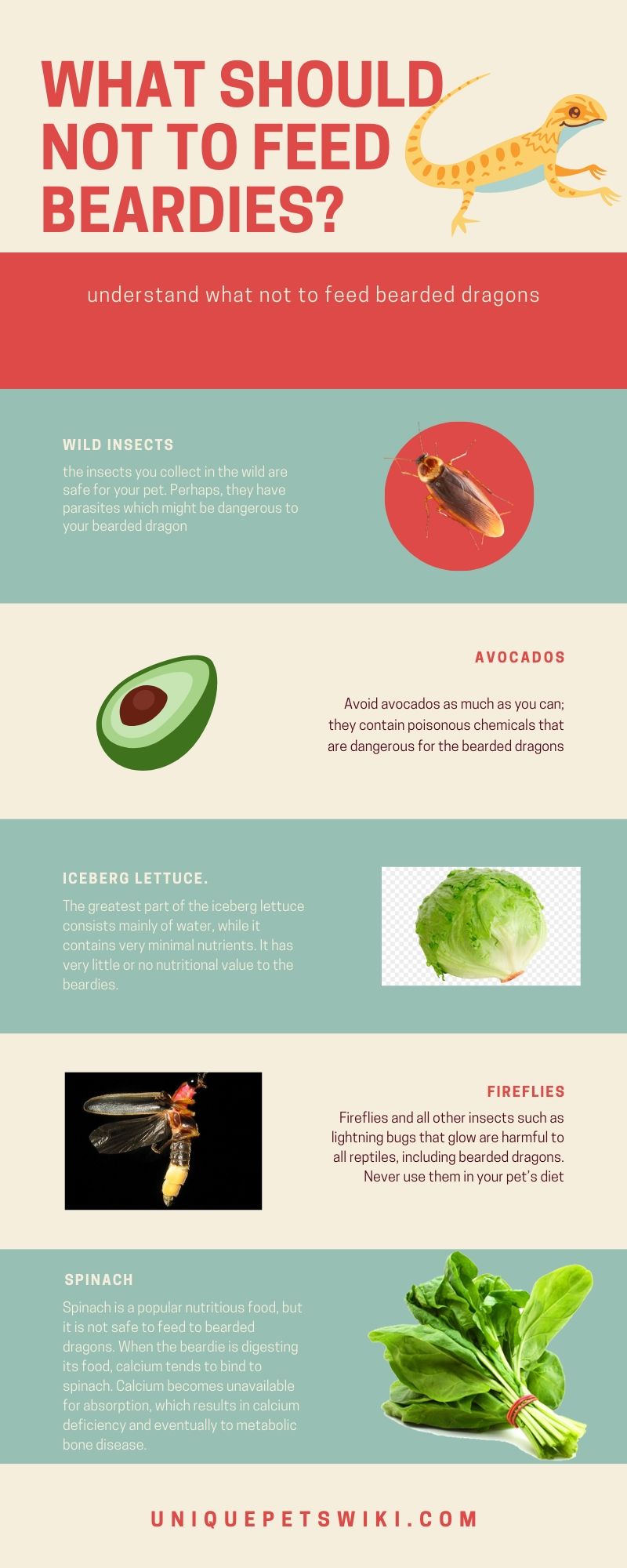
Some foods like rhubarb, avocado, fireflies, lettuce, spinach and beet tops although they have some useful nutrients, they are dangerous for bearded dragons. Wild insects are also harmful since they might contain deadly parasites.
The problem with fireflies is their glowing behavior which makes them toxic and threatening to the beardies. Rhubarb is high in oxalic acid that inhibits the uptake of calcium while avocados contain harmful chemicals which are unhealthy for bearded dragons.
How Do I Take Care of My Bearded Dragon?
Now you are aware that bearded dragons need to eat well, stay healthy, and live in comfortable and presentable habitats where they can thrive well.
As a responsible bearded dragon owner, you must know the various behaviors from these pets and know-how you need to respond. It is only after understanding the needs of your lizard pet that you will be able to give what is necessary.
Diet
Bearded dragons require a diet consisting of insect feeders and plant matter. If your dragon is a baby, the ratio of protein should be 80% and 20% plant matter. Adult bearded dragons require 20% protein and 80% veggies and fruits. Also, give fruits occasionally.
Keep in mind the calcium and phosphorus, size, and energy needs for bearded dragons. If you are not sure about a particular food, please don’t give it to your pet.
Daily Feeding and Cleaning Routine
How much food and how often to feed varies depending on the beardies age. Baby bearded dragons require to be provided three to four times daily. Allow them to eat as many insects as they can within a 10-15 minutes feeding period.
Juveniles require 50% of insects and 50% fruits and vegetables. You can feed them two to three times a day. The adults don’t eat a lot of insects to prevent them from becoming obese due to too much protein.
Ideally, an adult dragon should eat one or two times every day. They need more plant matters of around 80% and 20% of insects.
Make sure to remove all the foods remaining after the feeding period and dispose of them appropriately. Clean the dishes and bowls after every use, every day and disinfect them.
Handling and Bonding
Bearded dragons are incredibly docile, and they love it when you are handling them, but only after they are familiar with you. Who doesn’t enjoy picking and holding their beloved beardies?
You need to follow the right handling techniques to make sure that both you and your lizard are safe. Excessive and inappropriate handling annoys a beardie, and it might cause you injuries, or you might end up hurting it due to poor handling.
Lift your lizard slowly and carefully when handling it and the tail should rest upon your forearm. Keep the lizard close to your body to prevent it from falling from the arms.
A dragon bonds with you depending on how you treat it and the time you spend together.
Shedding

It is a normal process for a beardie to shed its skin. Baby bearded dragons are rapidly growing, and they tend to shed more often to make room for growth.
As they continue growing, the frequency of shedding decreases as physical growth also slows down. Visit your dragon daily to see if there are any shedding difficulties.
When you see the lizard rubbing against objects when trying to remove the old skin, regular misting will be helpful.
Related topic:
How often do bearded dragons shed?
Bathing
While some people bathe their bearded dragons every day, others prefer to clean them once a week.
Whichever way you chose, it depends upon you, but it’s good to avoid too many baths as they can stress the lizard.
But in case of shedding issues or constipation, you will need to bathe the beardie more often than you usually do it.
Bathing plays a significant role in hydration and softening the skin in case of shedding.
Brumation
During winter when the temperatures are too cold, many bearded dragons usually go into a deep sleep until the season is over. During this time, you may wake the dragon up and give some food if it accepts them.
Then, if the dragon is eating and drinking water, make sure to bath it regularly to encourage pooping. However, most bearded dragons will not eat nor drink during this period, and it is much better not to force them at all.
Cleaning the Habitat
The cage provides a small space compared to space the beardies have in the wild, and because of bowel movements, it can become messy.
Therefore, there is a need to clean the habitat regularly, at least once a week.
Some activities, such as cleaning up the leftovers, are part of daily maintenance and also removing the poop as soon as you spot it.
Other tasks, including replacing the substrate and cleaning the entire habitat and the accessories need to be done weekly or every other week.
Physical/Behavioral Health Symptoms
Bearded dragons express different behaviors that they use to communicate their mood, feeling, environment and health condition.
A sick or unhealthy dragon displays abnormal signs that you can quickly notice if you observe it keenly.
Most common issues in bearded dragons are impaction, dehydration, and diarrhea. You need to act quickly and accordingly in case you notice any of these problems to prevent adverse effects.
#1: Dehydration
Bearded dragons mostly obtain water from their diet and through bathing, but they rarely drink water directly from a bowl.
If your lizard is dehydrated, you are likely to observe the following signs;
- Wrinkled skin and it retains a holding shape after pinching it.
- Sunken eyes.
- Loss of appetite.
- Lethargy.
You can correct this by soaking the dragon in water and providing enough water. But make sure to visit a reptile vet if you don’t see the pet improving.
#2: Diarrhea
Bearded dragons may suffer from diarrhea due to a variety of reasons, including dirty water, stress, imbalanced diet, parasites, unhygienic cages, bacterial infections, etc.
You can tell if your dragon has diarrhea if you notice a watery, runny or liquid poop which produces a funky smell. The best thing to do when you suspect your pet has diarrhea is to take the stool to the vet for fecal testing and determine the underlying cause of the problem.
Consider giving the pet a bath to prevent it from becoming dehydrated due to too much diarrhea. Giving a slurry can also help to supply essential nutrients during this critical period.
#3: Impaction
Indigestible materials are the primary cause of impaction in bearded dragons as they tend to block the intestines. Some substrates like sand expose the beardies to impaction when they swallow them unintentionally.
Moreover, the insect’s exoskeleton is difficult to digest and will cause the same problem. Here are possible symptoms of impaction in the beardies.
- Lack of appetite.
- Lack of bowel movement.
- The stomach feels hard to touch.
- A black beard.
In the case of impaction, consult the vet first before engaging in any home remedy. Typically, people address the impaction issues in their pet by giving them a few drops of olive oil and then a bath for a half an hour in lukewarm water.
15 Fun Facts About Bearded Dragons
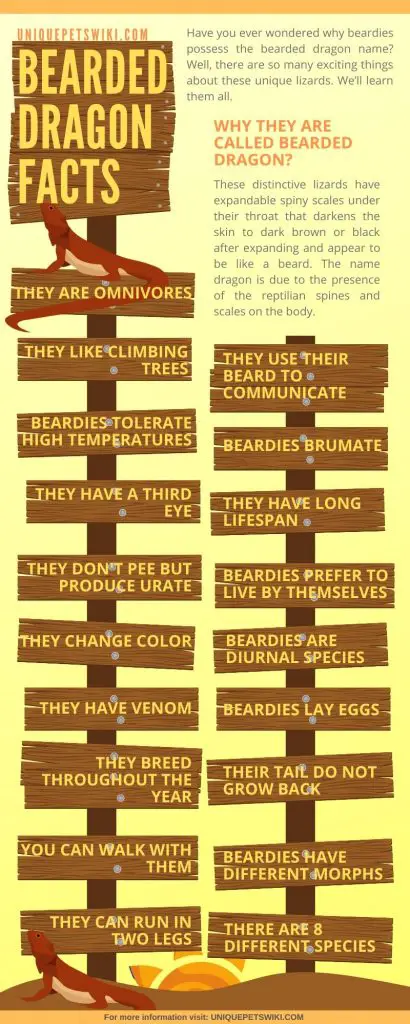
Bearded dragons are unique pets with a variety of behaviors that they display for different reasons. Let’s explore the fun facts about bearded dragons for you to know your lizard more.
Head-bobbing
Head bobbing is standard behavior in males, and they express it when they want to mate or to show territoriality. Females also tend to nod their head during mating as a sign that they accept to mate.
Females also respond to males by head-bobbing as a way to recognize the male’s authority. The only difference is that head-bobbing in males is fast, but females tend to do it slowly.
Black Beard
Similarly, to head-bobbing, both males and females show black bearding. When you notice a black beard in your lizard, it could be due to a couple of reasons.
In most occasions, the beardies have a black beard as a way of showing that they are angry, scared, sick, seeking a mate, not comfortable with you, feel lonely, or because of stress.
You might also observe a black beard in your dragon after brumation, which is normal. When there is more than one bearded dragon in one cage, black bearding is common to show territoriality.
Additionally, a bearded dragon can turn its beard black when it gets into a new surrounding and meets new people.
This happens mostly after buying a dragon and introducing it to your home where everything is new to it.
Arm-waving
Arm-waving is another typical behavior in bearded dragons, and it serves as a communication tool for different reasons. Some people think that their beardie is saying hello when they wave at them, but that is not the case.
Of course, a bearded dragon usually waves to another bearded dragon; they do this for species recognition, submission, or to demonstrate mating behavior. Arm-waving is entertaining to watch, especially when the beardies are in a group and all waving their arms.
Bearded Dragons Come in Different Morphs
Interestingly, bearded dragons belonging to the same genus and species don’t look the same. There are nine morphs of the beardies, and they all differ from each other in the way they look like body color and patterns.
Breeding is common in bearded dragons just like in other reptiles. The beardie’s scalation, pattern or color is due to the interaction of several genes.
It is also not unheard of that bearded dragons change their color, and they do so to blend with the environment and for thermoregulation reasons.
Some morphs like standard, leatherback, and hypomelanistic are extremely popular while others like zero morph are rare to find.
Bearded Dragons can Run on Two Legs
Running on two legs mostly happens when the beardies are running at high speed from predators. As the beardie is running, the centre of gravity moves towards the back of the body and enhances the beardie to pick up much higher speed.
At this speed, bearded dragons cannot keep their front legs on the ground, and that is the reason why they lock them and run using the hind legs. This also increases their maneuverability.
The Beardies can Swim Perfectly
Despite being the desert animals, bearded dragons enjoy being in the water, and they tend to swim correctly. They inflate their body with air, and this enables them to float on water and start swimming.
However, you should note that bearded dragons have a different personality. While some dragons love swimming, some cannot even hop in the water. It is good to respect your dragon’s character; if it doesn’t want to swim then don’t force it.
Another vital thing to consider is allowing your dragon to swim in lukewarm water. Swimming mostly happens when you are bathing the lizard and is an excellent way to make bearded dragons have their bowel movement and do exercise.
Bearded Dragons can Run up to 9mph
If you keep your lizard in its enclosure most of the time, you might think it is a lazy animal. But bearded dragons are smart at exercising and running. Inside the tank, there is no room for expressing all the beardie’s behavior, such as running.
The beardies can run faster than you can imagine. They tend to run up to 9mph, especially when escaping from the predators in the wild. It is a natural behavior to them, and that’s why you need to allow your pet to have a good time walking in the compound more often.
You can have some food at a distance, allow the lizard to spot them and it will shoot off to it. This is good training to give your beloved pet.
They are Exceedingly Affectionate
Owning a bearded dragon is much fun, and you will never get bored of being around it. Every pet owner desires to have pets that love them back, and bearded dragons are a good choice when it comes to displaying affection.
Typically, the beardies recognize their owners, appreciate and enjoy their presence, and love warming up to them. Does your lizard friend climb up on the back of your neck and then sleep? The pet is merely enjoying your warmth and reveals that it likes you.
To maintain a good bond between you and your beloved dragons, make sure to always handle it gently and with care.
Bearded Dragons can Sleep while Standing
Bearded dragons tend to sleep standing while leaning against the glass or any foliage available in the terrarium, and this is standard behavior.
If you are seeing this sleeping position for the first time, it may seem weird, but there is nothing to make you worry. Bearded dragons have got odd sleeping positions, and they sleep in any posture they want.
Buying a hammock and placing it in the enclosure can also help the dragon to have a more comfortable sleep.
They Sit with their Mouth Open
Have you ever seen a dog panting? Bearded dragons can also keep their mouth open, and many people who aren’t familiar with this kind of behavior get pretty worried.
Just like dogs, your dragon can sit with its mouth open when it is too hot as a way of trying to cool itself down. Bearded lizards can sometimes get lazy (just like us), mainly due to extreme temperatures in the enclosure.
So, next time you see your pet sitting with its mouth open, don’t panic but ensure to check if temperatures are within the range in the cage.
Eye Bulging
Eye bulging is the weirdest behavior in bearded dragons, and it tends to scare most of the owners who don’t understand what is happening. Seeing my dragon bulging its eye for the first time, it was incredibly scary, and I thought the lizard was possessed.
But I came to realize that this is normal behavior and bearded dragons display it when they are about to stretch the skin and make shedding easy around the eyes.
Moreover, bearded dragons can bulge their eyes for other reasons like itching and yawning. It is also believed that eye-bulging can be due to high blood pressure.
However, there is no real scientific explanation towards that, but scientists are just trying to show that eye-bulging doesn’t happen unintentionally.
Bearded Dragons Express Dominance and are Good in Bullying
In the wild, bearded dragons only come together when they want to mate, and they part their way after mating. That shows how solitary they are, and they need to stay alone, even in captivity.
If you house more than one dragon in the same enclosure, it requires you to keep an eye on your pets and check out for dominance and bullying. Dominant bearded dragons demand that all the other dragons recognize their authority and be submissive.
Failure to do so, a fight will break out, and some dragons, especially those with small bodies might end up with injuries. Also, if you notice that one dragon is losing weight while the other is thriving, that’s enough evidence that there’s bullying.
And if that is the case, you will need to separate your lizards. It’s not natural for bearded dragons to share a single habitat.
Bearded Dragons Stress Marks
Stress marks in bearded dragons occur mostly due to stress. We are happy to move our dearest dragons to new enclosures or introduce new things inside the habitat. However, you always need to remember that what you love isn’t what your pet wants.
The beardies always feel insecure seeing anything new around them, whether its new people, terrariums, household pets, or accessories in the enclosure. This is enough to cause stress, and then stress marks appear on the belly, limbs or beard.
Shedding Process
Bearded dragons don’t grow with their skin; they have to shed the old skin to allow room for growth and develop new skin eventually. Shedding isn’t something new, and it occurs more often in baby bearded dragons as they are still growing.
The pattern of shedding differs from time to time or from one dragon to another. A dragon can lose all the old skin at once or begin shedding from one end to the other.
Sometimes there’s partial shedding, and some skin remains in some parts of the body, and they appear to be hanging. You can give your dragon a bath to encourage it to shed the remaining skin but never attempt to pull it because it can cause injuries.
When the dragon wants to shed, the skin ready for shedding appears white. Some beardies will keep off from food and become pretty quiet.
Bearded Dragons Like to Climb Trees
If you have a bearded dragon, then I believe you have seen it climbing on the branches in the terrarium. The beardies are semi-arboreal, mostly the young ones and they enjoy spending a good time hanging out on high places in the enclosure.
This also contributes to their ability to move up and hang out on their owner’s shoulder. The beardies can even sleep up high on the branches.
To read more on bearded dragon care, we recommend ‘The Bearded Dragon Manual’, 2nd Edition by Philippe De Vosjoil. The book contains expert advice for keeping and caring for a healthy bearded dragon.
Last update on 2023-01-02 / Affiliate links / Images from Amazon Product Advertising API
Conclusion
Proper care is essential for bearded dragon’s health, comfort, and happiness. Caring for the beardies means that you have to consider their dietary needs, enclosure conditions, health, handling, environment, among others.
But above everything else, make sure you buy a healthy bearded dragon. And for that matter, make your purchase from the pet sellers with a good reputation. Buying healthy pets help you to reduce treatment costs and enjoy a long companionship with your lizard.
